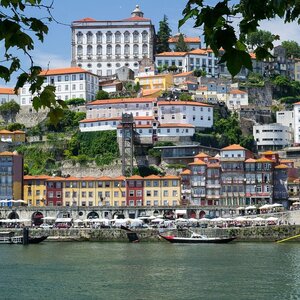Worst European cities for American digital nomads
The post Worst European cities for American digital nomads appeared first on TD (Travel Daily Media) Travel Daily.
A new ranking has revealed which European capital cities are the best for Americans to work remotely this year – with Bucharest crowned the winner.
The ranking was created by digital nomad visa expert Nomad Capitalist, with each capital city scored based on four key factors – accessibility, affordability, logistics, and longevity.
Accessibility looks at the average return flight cost to each capital city from America (flying from JFK or LAX), the current Schengen visa approval rate for those looking to stay for up to 90 days, and the percentage of the local population who speak English fluently.
Affordability accounts for monthly rent, utility, transport, and typical food expenditure in each city – and how this compares to the average monthly salary for Americans ($4,588).
Logistics looked at the local broadband quality, how the time difference compares to America (Washington D.C.), and the density of co-working spaces in each city center.
Longevity calculates the long-term value of putting down roots in each city. According to Nomad Capitalist’s Passport Index, it assigns each country a score for perception (how the citizens are received), the ease of getting dual citizenship, and tax considerations.
When all factors are considered, it turns out that Bucharest in Romania is the best place to visit for those looking to work abroad this year, as it scored 33.4 out of 40 overall.
This high score is largely attributed to the reasonable return flight cost of $544 – 47% less than a return flight to Rome ($1,031) – and the Schengen visa approval rate of 93%.
The city is also one of the most affordable destinations analyzed in the study, as once rent, utilities, transport, and groceries are accounted for, the average American should have $3,739 of their salary left to play with (equivalent to 16,647 Romanian lei).
Following Bucharest as the best capital city for a remote working stint is Copenhagen in Denmark, which scored well for broadband speed (208.6 Mbps) and remote working spaces, with Google Maps showing 20 buildings are available in the city center.
Dublin in Ireland rounds out the top three, scoring particularly highly for long-term desirability. Americans might want to extend their stay in the city or pursue dual citizenship to benefit from low tax rates and good public perception.
Despite Dublin scoring highly, the results revealed that London in the UK placed in the bottom five least-suitable cities for US remote workers, as it was largely let down by its affordability when compared to the typical US salary.
With an average combined rent and utility cost that’s equivalent to $2,665, and a monthly food spend of $247 – on top of transport costs – an American visitor would only have $1,417 left to play with after covering their essential expenses. That’s compared to the $2,643 they’d have spare in Paris.
The city also scored poorly for longevity, as Nomad Capitalist’s Passport Index reveals that the public perception of UK residents isn’t as positive when compared to other areas, as they score it a 20 out of 50. Meanwhile, Dublin, Lisbon, and Bern all scored a perfect 50.
Surprisngly, London also reported some of the slowest broadband speeds when compared to the other capitals, averaging 90 Mbps compared to Madrid’s 226, and Bucharest’s 216.
Joining the Big Smoke as one of the least desirable destinations for digital nomads is Minsk in Belarus, which also scored poorly for longevity, and was among the worst cities overall when it comes to affordability, due to its high living costs.
Overall, the least suitable city came out as Monaco, which scored just 9.3 /40. This is largely due to its affordability driven by a local ‘luxury lifestyle’, with the local rent, utilities, transport and grocery costs leaving the average American overdrawn by a huge $3,130 a month.
City
Suitability Score
Worst-Performing Factor
City
Suitability Score
Worst-Performing Factor
1
Monaco
9.33 /40
Affordability
6
Podgorica
26.9 /40
Logistics
2
Minsk
24.4 /40
Longevity
7
Sarajevo
28.1 /40
Logistics
3
Chisinau
24.8 /40
Affordability
8
Amsterdam
28.2 /40
Affordability
4
Andorra la Vella
25.3 /40
Accessibility
9
28.4 /40
Accessibility
5
London
26.9 /40
Affordability
10
Valletta
28.5 /40
Logistics
Surprisingly, despite being a coveted holiday destination among Americans, Paris didn’t score much better than London, and ranked 26th with a suitability score of 29 /40 – placing it slightly ahead of Rome, which scored 28.9.
While there’s not a massive margin in the end scores, there were significant differences across the four metrics, with Paris let down by its accessibility; flights prove expensive from LAX and JFK at an average of $883, and the Schengen Visa approval rate stands at 82%.
Long-term desirability could also be improved in the ‘City of Light’, as its longevity score was pulled down by tax considerations, and how its citizens are perceived could be better.
Speaking on the findings, Andrew Henderson, founder and travel expert at Nomad Capitalist said: “The interest in becoming a digital nomad has risen in recent years, as Americans look to take advantage of remote positions and flexible companies that encourage travel.
“Just recently, we’ve seen Canada call remote workers to visit for up to six months at a time, stating they’ll consider additional policies to attract digital nomads. It’ll be interesting to see which other countries and capital cities analyzed in the ranking will follow suit, as they can benefit from attracting foreign talent and diversifying their work-life culture.
The post Worst European cities for American digital nomads appeared first on Travel Daily.











